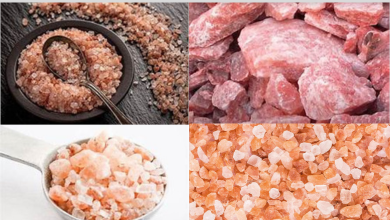 Health
Health
Rock Salt - Difference Between white and rock salt
* Formation -
Halite, commonly known as Rock salt is a mineral formed from sodium chloride. It’s chemical formula is NaCl and this also includes other variations of salt such as common salt and table salt. Rock salt is the industrial name for Halite which forms Isometric crystals.
The mineral is colourless but also might be purple, pink, blue etc depending on the impurities mixed with it and structural or isotopic abnormalities in the crystals.
It occurs commonly with sulphates, borates and halides in beds of sedimentary evaporite minerals which is caused by large seas drying up and can be hundreds of metres deep.
In India, the only deposit of rock salt is reported from Mandi district, Himachal Pradesh. It is dark purple, opaque and contains many impurities. It is a type of salt with all the same properties as regular salt but with some major benefits - Himalayan Pink Salt.
* History -
In diverse cultures around the world, rock salt has earned a special place in culinary traditions and religious practices. Its culinary reputation extends beyond ordinary seasoning, as it infuses dishes with a complex earthy flavour that delights the palate while enhancing its mineral content at the same time. Cooks embrace the coarse texture of rock salt because of its slow dissolution, which gently releases bursts of flavours to enhance every atom of food.
* Difference between Rock salt and Salt-
Rock salt continues to remain a healthy choice between individuals who are seeking natural alternative to regular table salt.
Kala namak is also not same as Rock salt - Sendha namak or Himalayan Pink Salt.
Rock salt has a relatively lower sodium content compared to common table salt due to its larger crystal size making it suitable for people suffering from High Blood pressure or looking to regulate their sodium intake.
It can aid in weight loss and restores hormonal balance.
According to Ayurveda, rock salt dilutes all three doshas and is especially recommended for reducing the Pitta Dosha or heat in the body and it is the recommended choice for fasting foods and helps to enhance digestion and detoxification.
In contrast, kala namak, or black salt is mainly used for reducing gas and indigestion.
Other than being used for fasting foods, Sendha Namak’s unique flavour profile makes it a delicious addition to many foods and beverages.
* Conclusion -
Rock salt is a tasty and healthy alternative to the traditional table salt and should be included in daily food habits in order to regulate body and its functioning. Health is the biggest concern today and something as crucial as salt in food can result in the minute yet remarkable changes and can sufficiently increase life expectancy!








